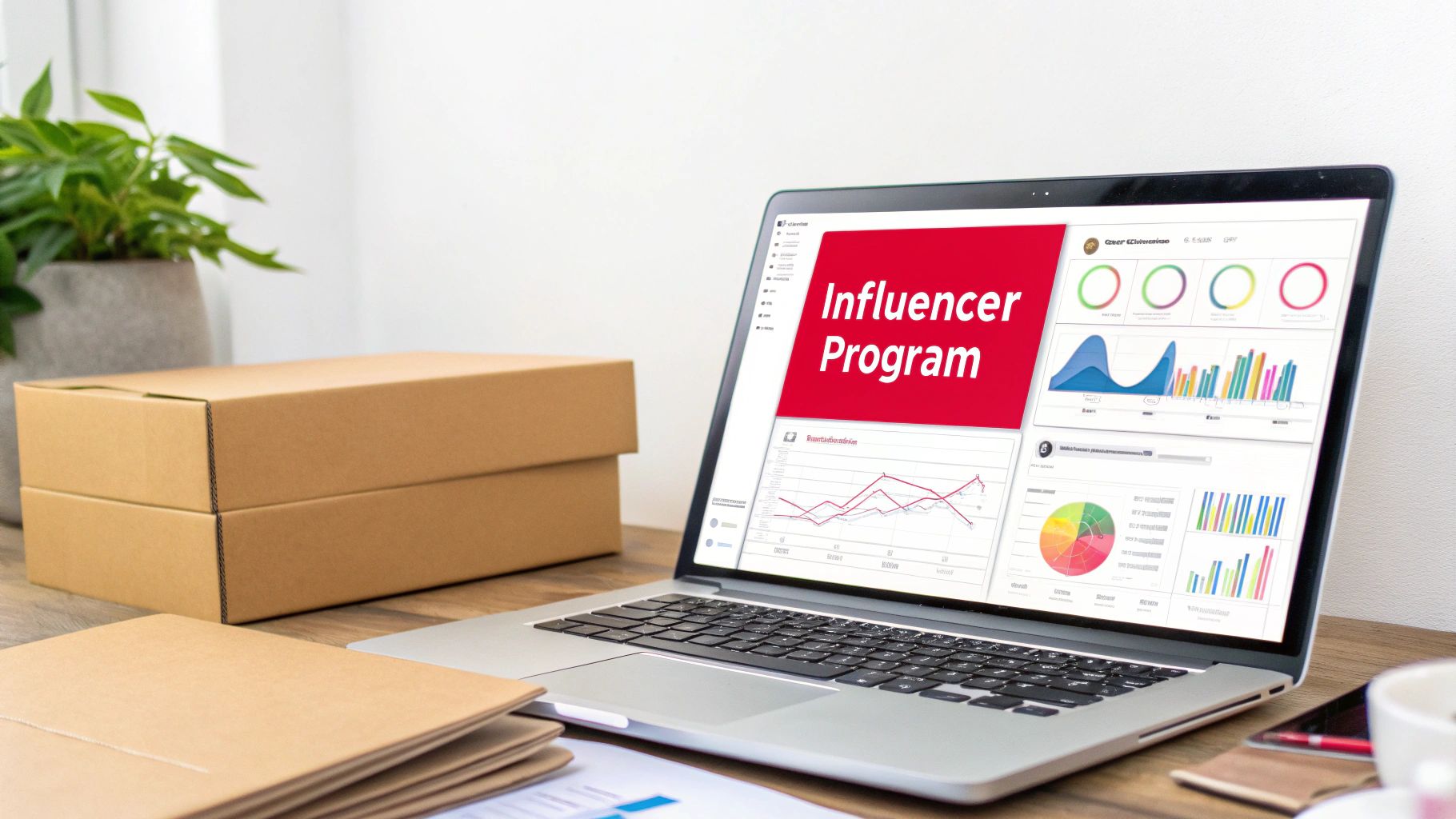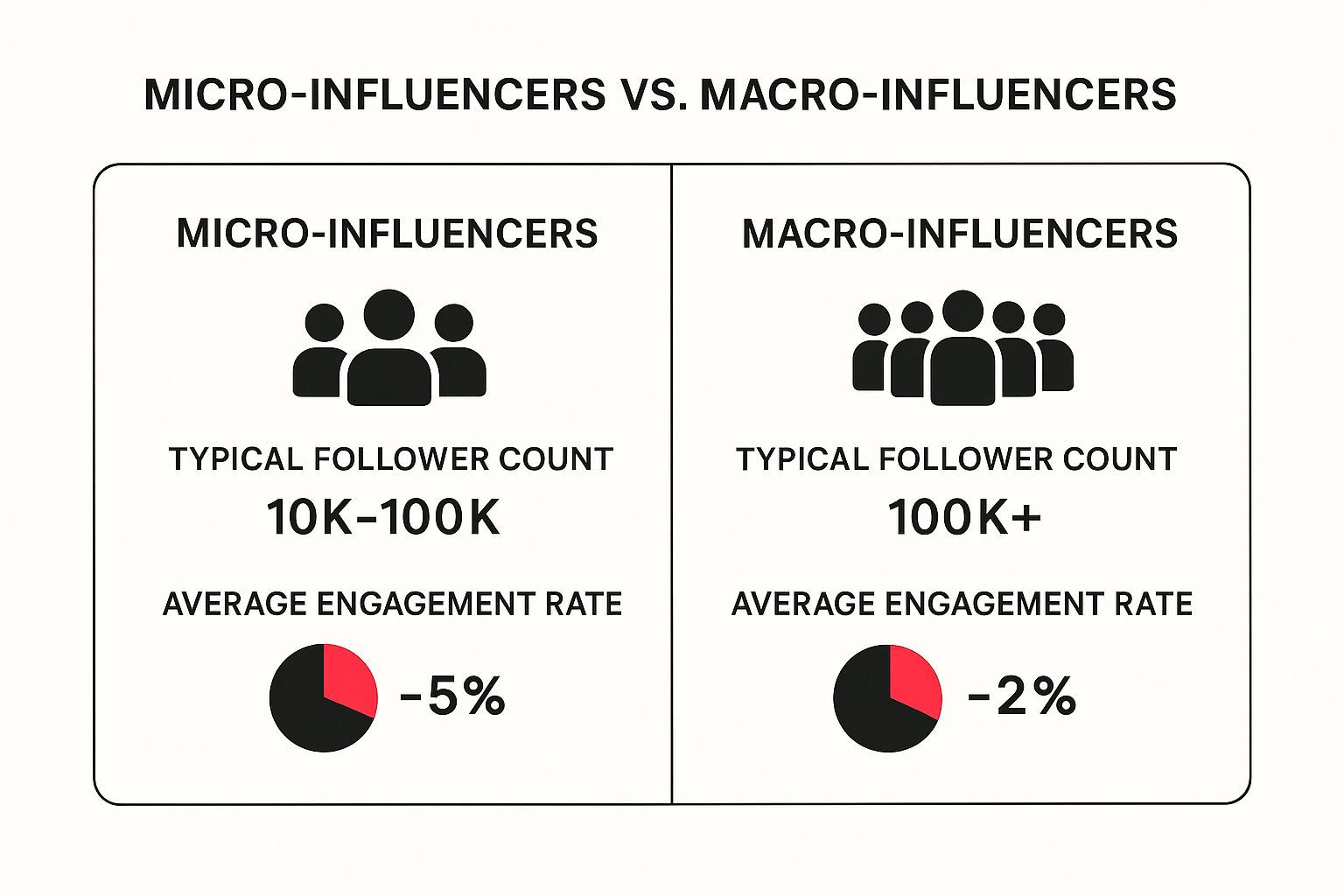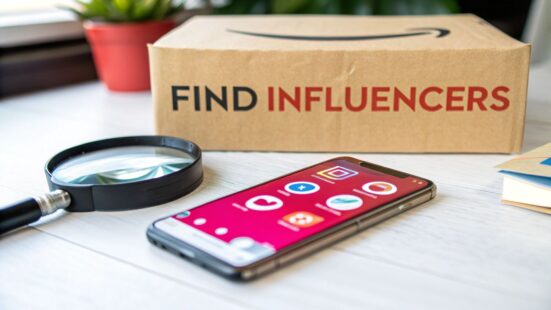 Find Influencers LinkedIn: A-Z Guide, Criteria, Precautions, Pros, FAQs
Find Influencers LinkedIn: A-Z Guide, Criteria, Precautions, Pros, FAQs
Table of Contents
Cracking The Amazon Influencer Code
Finding the right Amazon influencers can significantly boost your brand’s visibility and sales. However, the Amazon influencer landscape is unique. Unlike platforms that prioritize vanity metrics, Amazon influencers directly impact your bottom line. This direct connection stems from the inherent trust within Amazon’s shopping environment and provides conversion advantages you won’t find on traditional social media platforms.
Why Amazon Influencers Matter
This shopping-first mentality creates unique partnership opportunities. Successful brands identify the right type of influencer, whether micro-influencers with niche audiences or macro-influencers with broader reach.
For example, a new skincare brand might partner with a micro-influencer specializing in organic beauty. Meanwhile, a larger electronics brand could leverage a macro-influencer for wider product awareness. This targeted approach ensures your message reaches the most receptive customers.
The Power of Influencer Marketing
Finding Amazon influencers involves understanding the scale and potential of influencer marketing on the platform. As of 2025, Amazon influencers can earn commissions between 1% to 20% on sales, depending on the product category, paid directly by Amazon. This lucrative commission structure contributes to why influencer marketing has become a significant strategy for brands to boost sales.
With over 55% of social media users admitting to making influencer-inspired purchases on Amazon, the platform offers a powerful channel to reach engaged audiences. Influencers often charge additional fees for creating and promoting branded content, varying based on reach and engagement metrics.
Consequently, partnering with Amazon influencers requires careful consideration of both their commission rates and additional promotional costs to maximize ROI. The global influencer marketing market is projected to reach $22.2 billion by 2025, indicating strong growth in this space. Explore this topic further here.

Choosing The Right Influencers For Your Brand
Choosing the right influencer involves balancing reach, engagement, and budget. Additionally, consider factors like content quality and brand alignment. Does the influencer’s style resonate with your brand’s message? Do they create high-quality, engaging content that resonates with their audience?
These questions are crucial to successful partnerships. Ultimately, finding the perfect Amazon influencer involves a strategic approach that considers your specific brand goals and target audience.
Smart Tools That Actually Find The Right Partners
Finding the right Amazon influencers can feel like a daunting task. But smart brands are moving beyond endless scrolling and embracing influencer discovery tools. These tools help cut through the clutter and identify authentic partnership opportunities.
AI-Powered Matching and Advanced Filtering
Many platforms use AI-powered matching to analyze audience compatibility. This ensures the influencers you connect with have an audience that truly aligns with your target demographics. Robust databases with advanced filtering let you refine your search by criteria like niche, engagement rate, and follower count.
This means you can quickly identify the right influencers for your brand and campaign, instead of manually reviewing countless profiles. Want to improve your overall influencer marketing strategy? Check out this helpful resource: How to master influencer marketing best practices.
Evaluating Tools Based On Your Goals
Evaluating these tools requires considering your budget and objectives. Some platforms offer basic features at affordable prices, while others provide advanced analytics and campaign management at a premium. Choosing a tool that aligns with your specific needs and resources is essential.
For example, a startup on a tight budget might choose a tool with basic search and filtering. A larger brand with more resources might invest in a platform with advanced features like AI-powered matching and detailed performance tracking. Finding the right Amazon influencers is becoming easier thanks to advanced tools. AI-powered influencer matching technology is a key trend, helping brands identify suitable influencers based on data. Strategies like whitelisting and paid amplification are also gaining traction. Discover more insights about Amazon Influencer marketing trends.
Micro vs. Macro Influencers: A Data-Driven View
The following infographic highlights the key differences between micro and macro-influencers, focusing on follower counts and engagement rates.

As the infographic shows, micro-influencers typically have smaller follower counts (between 10K and 100K) but often have higher engagement rates (around 5%). Macro-influencers have larger follower counts (100K+) but typically lower engagement rates (around 2%). This difference underscores the importance of choosing the right type of influencer for your campaign goals.
To help you further in your search, the following table compares several popular influencer discovery tools:
Influencer Discovery Tools Comparison: A comprehensive comparison of top influencer discovery platforms, their features, and pricing structures.
| Platform | Key Features | Pricing Range | Best For |
|---|---|---|---|
| Upfluence | Influencer search & discovery, campaign management, analytics | $99 – $2,999/month | Businesses of all sizes |
| HypeAuditor | Influencer analytics, fraud detection, audience analysis | $30 – $1,000/month | Brands and agencies focused on Instagram, TikTok, and YouTube |
| Heepsy | Influencer search & discovery, contact information, fake follower check | $49 – $299/month | Small to medium businesses |
| Grin | Influencer relationship management, campaign tracking, product seeding | Contact for pricing | E-commerce brands |
This table provides a starting point for your research. Remember to consider your specific needs and budget when making your final decision.
By understanding these tools and the differences between influencer types, you can build more effective influencer marketing campaigns.
Finding Hidden Gems Through Strategic Manual Research
While software tools like Outrank are invaluable for influencer marketing, manual research often uncovers hidden gem partnerships that automated systems miss. This hands-on approach helps you identify emerging Amazon influencers before they’re saturated with brand deals, allowing you to foster more authentic, mutually beneficial relationships.
Mining Amazon’s Platform for Influencer Gold
Start your search directly on the Amazon platform. Analyzing product reviews reveals engaged users who demonstrate a genuine passion for your product category. These individuals might be up-and-coming influencers ready for a partnership.
Additionally, exploring Amazon Live and active storefronts can connect you with influencers already engaged with your target audience. These methods provide a direct link to individuals actively involved in the Amazon ecosystem.
For example, if you sell kitchen gadgets, look for detailed, enthusiastic reviews of similar products. The reviewers might be active on social media platforms like Instagram or TikTok and open to collaborations. This targeted approach allows you to connect with individuals who already appreciate your niche.
Unveiling Influencers Through Social Media Sleuthing
Strategic social media exploration is key to finding Amazon influencers. Hashtag research, using relevant terms like #amazonfinds or #amazonmusthaves, reveals influencers actively promoting products on the platform.
Furthermore, competitor analysis reveals which influencers are already driving results in your space. This provides valuable insights into successful influencer partnerships within your industry.
Once you’ve identified potential Amazon influencers, broadening your partnership strategy can be beneficial. Consider learning more about how to find a business partner to strengthen your overall business strategy.
Building a Sustainable Influencer Discovery Process
Successful brands combine manual research with their existing tech stack. This creates a first-mover advantage, allowing you to connect with influencers before your competitors.
This proactive approach also often results in more favorable partnership terms and stronger, longer-lasting relationships. Building a sustainable process ensures you’re continuously identifying new influencer opportunities. This continuous discovery is crucial for long-term growth in the competitive landscape of Amazon influencer marketing.

Separating Real Influencers From Marketing Noise
Follower counts can be misleading. Fake engagement is everywhere. Brands that see a strong return on investment (ROI) from Amazon influencer partnerships know the difference between genuine influence and inflated numbers. This skill is essential for successful influencer marketing on Amazon.
Identifying Authentic Engagement and Audience Demographics
Analyzing engagement is vital when evaluating potential influencers. Look past the sheer number of likes and comments. Do the comments appear authentic and relevant? Is engagement consistent across posts, or are there suspicious spikes? These are critical questions to ask.
Understanding the influencer’s audience demographics is equally important. Does their audience match your target market? An influencer with millions of followers might seem attractive, but if their audience doesn’t overlap with yours, the partnership won’t be effective. For instance, a gaming accessory brand wouldn’t benefit from a beauty influencer, regardless of follower count.
Evaluating Content Quality and Brand Alignment
Content quality is another key factor. Does the influencer create high-quality, engaging content that their audience loves? Does their style match your brand’s values and message? A style mismatch can alienate your target audience.
Brand alignment goes beyond just aesthetics. Consider the influencer’s overall online presence. Do they promote products that conflict with your brand’s values? Are they involved in any controversies that could hurt your brand? These factors can significantly affect the partnership’s success.
Spotting Red Flags: Fake Followers and Manufactured Engagement
Recognizing red flags is crucial to protecting your budget. Sudden follower increases, a high follower-to-engagement ratio, and generic comments can all point to fake followers or manufactured engagement. These tactics create an illusion of influence, but rarely lead to sales.
For example, an influencer with 100,000 followers but an average of only 50 likes and 10 comments per post is suspicious. This low engagement rate suggests many followers are inactive or fake accounts. You might be interested in: How to find the right influencers for your brand.
Assessing Storytelling, Product Integration, and Purchasing Power
Ultimately, a successful Amazon influencer partnership hinges on several key things. Evaluate the influencer’s ability to tell compelling stories, integrate products naturally, and, crucially, influence purchasing decisions.
Real influence drives real results. By focusing on these indicators, you can find the Amazon influencers who will genuinely benefit your brand and avoid costly mistakes.
Outreach That Gets Results Instead Of Ignored
Identifying the perfect Amazon influencers is only half the battle. Your outreach can make or break potential partnerships. The difference between brands that secure collaborations and those that get ignored? Their communication strategy.
Crafting Personalized Messages That Resonate
Forget generic templates. Influencers receive countless outreach messages daily. To stand out, your communication must be personalized. It needs to show you understand their content and audience. This means going beyond just mentioning their name. You need to genuinely engage with their work.
Referencing a specific video or post, for example, proves you’ve taken the time to understand their style. This personalized approach shows real interest, increasing the likelihood of a positive response. It’s like any business relationship: authenticity is key. For more connection-building tips, check out this helpful resource: How to master influencer marketing outreach.
Timing, Follow-Up, and Negotiation Tactics
Timing is crucial. Reaching out when an influencer is busy will likely result in your message being overlooked. Research their posting schedule. Try contacting them during less active periods.
A well-structured follow-up sequence is also essential. A polite follow-up a few days after your initial message can significantly boost your response rate. Avoid excessive follow-ups, though. This can come across as pushy. Effective negotiation is also key. Be prepared to discuss terms, deliverables, and compensation professionally.
Presenting Compelling Partnership Proposals
Your proposal should clearly communicate the value for both parties. What are you offering the influencer? What do you hope to achieve?
A compelling proposal outlines the benefits of collaboration. This might include increased exposure, access to your audience, and the potential for a long-term partnership. It shows your commitment to a mutually beneficial relationship, not just a one-off transaction. Offering exclusive content or early access to new products can sweeten the deal and encourage collaboration.
Building Long-Term Relationships for Consistent Results
Focus on building lasting relationships, not just one-off transactions. These relationships lead to more authentic and effective partnerships. Consistent collaboration builds trust with their audience, leading to increased brand awareness and sales over time.
By implementing these strategies, you can transform your outreach. Move from ignored messages to compelling invitations for collaboration. This approach fosters strong, mutually beneficial relationships that drive consistent results.
Measuring What Matters and Optimizing for Growth
Even the most successful Amazon influencer partnerships can fall short of their potential without a solid approach to measurement. Brands that truly excel in this arena have established systematic processes for tracking performance and optimizing their results. This involves identifying key performance indicators (KPIs) before campaign launch and using attribution methods specific to the Amazon marketplace.
Measuring Direct Sales Impact and Brand Awareness
Measuring the impact of your influencer campaigns requires a multifaceted approach. This means looking at both the direct sales impact and the overall brand awareness generated to get a complete picture of your partnership ROI.
Direct sales are the most straightforward metric. Track the number of sales generated through each influencer’s unique links or promotional codes. This data provides a concrete measure of the immediate impact of the partnership.
Brand awareness, while more challenging to quantify, is also crucial. Look for increases in brand searches, social media mentions, and website traffic following an influencer campaign.
For example, a spike in searches for your brand name on Amazon after an influencer’s post clearly indicates increased brand awareness. This broader perspective helps you fully evaluate the long-term value of your influencer collaborations.
Gathering Actionable Feedback and Creating Improvement Cycles
Gather feedback from both influencers and their audiences. Influencers can offer valuable insights into what resonated with their followers and areas for improvement. Audience feedback, collected through comments, polls, or surveys, provides a direct line to customer perceptions.
Use this feedback to establish improvement cycles. Ask yourself what worked well and what didn’t. This continuous optimization is essential for maximizing the impact of future campaigns. To optimize your outreach process, consider streamlining your social media content creation workflow.
Scaling Successful Partnerships and Renegotiating Terms
Discovering how to find Amazon influencers is just the first step. Once you’ve established successful partnerships, the next step is scaling them. This might involve increasing the scope of existing collaborations, expanding to new product lines, or exploring different content formats.
Leverage performance data to renegotiate terms. If an influencer consistently delivers strong results, they may have earned a higher commission rate or increased compensation. This performance-based approach ensures fair compensation and incentivizes continued success.
Building Systematic Relationship Management Processes
Finally, building systematic relationship management processes is vital for long-term growth. This involves maintaining regular communication with influencers, providing them with the resources they need, and fostering authentic, mutually beneficial relationships. Much like customer relationship management (CRM), a structured approach to influencer relationships lays the groundwork for consistent, sustainable growth.
The following table provides a summary of the key metrics you should track for successful Amazon influencer partnerships:
Influencer Partnership Success Metrics
Key performance indicators and benchmarks for measuring Amazon influencer campaign effectiveness.
| Metric | How to Measure | Good Benchmark | Optimization Tips |
|---|---|---|---|
| Direct Sales | Track sales using unique links or codes | Varies by product and niche | Offer exclusive discounts or product bundles |
| Conversion Rate | Percentage of clicks that convert into sales | 1-5% (or higher) | Optimize product pages and calls to action |
| Engagement Rate | Likes, comments, shares on influencer content | Varies by platform and influencer | Encourage audience interaction and questions |
| Brand Mentions | Track mentions of your brand across social media and Amazon | Consistent increase after campaign | Run contests or giveaways to boost mentions |
| Website Traffic | Monitor referral traffic from influencer platforms | Noticeable increase after campaign | Include clear and compelling links to your website |
By tracking these metrics and implementing systematic processes, you can elevate your influencer marketing from a series of individual campaigns to a powerful driver of consistent growth.
Advanced Strategies That Create Competitive Advantages
As Amazon influencer marketing grows more complex, simple tactics just won’t cut it. Brands that truly shine in this arena are leveraging advanced strategies to unlock the full potential of their partnerships. These strategies are what set the leaders apart.
Micro-Influencer Network Development
Instead of betting everything on a few big-name influencers, creating a micro-influencer network offers wider reach and more meaningful engagement. This involves teaming up with numerous micro-influencers, each possessing a dedicated following within a particular niche. Imagine a network of specialized brand ambassadors, each connecting with a distinct segment of your target audience.
This method has distinct advantages. Micro-influencers typically boast higher engagement rates than their macro counterparts. A diversified network also reduces your dependence on any single partnership. Plus, it enables highly targeted campaigns.
Cross-Platform Campaign Integration
Integrating your Amazon influencer campaigns across various platforms amplifies their impact and reach. Don’t confine your partnerships solely to Amazon. Encourage influencers to promote your products on other platforms where their audience thrives, such as Instagram, TikTok, and YouTube. This cross-platform promotion creates synergy, reinforcing your message and broadening your audience. An influencer might create an unboxing video on YouTube, include a link to their Amazon storefront in the video description, and then further promote the product on Instagram Stories.
Seasonal Optimization Strategies
Timing is crucial. Optimize your influencer campaigns around peak shopping periods like Prime Day, Black Friday, and the holiday season. These times offer increased consumer interest and buying intent, maximizing the effect of influencer promotion. Consider launching special product bundles, offering exclusive discounts, or crafting themed content around the specific season. By syncing your campaigns with these high-traffic times, you can significantly boost sales.
Exclusive Partnership Arrangements
Forge exclusive partnerships to gain a competitive edge. This could involve offering an influencer a unique product bundle, providing early access to new product releases, or even developing a co-branded product. These exclusive arrangements set your brand apart and cultivate a sense of urgency, encouraging purchases.
Building Adaptive Influencer Programs
The Amazon landscape is dynamic. Creating an adaptive influencer program is key. This involves consistently evaluating performance, staying informed about platform updates, and remaining flexible in your strategies.
This adaptability ensures your influencer marketing remains effective, even amidst algorithm shifts or changing market dynamics. This might mean integrating new technologies, adapting content formats, or testing new platforms.
By implementing these advanced strategies, you can maximize the power of Amazon influencer marketing and achieve outstanding results. Interested in elevating your Amazon influencer marketing? JoinBrands offers a comprehensive platform to discover, connect with, and manage influencer collaborations seamlessly. Learn more about how JoinBrands can help you find the perfect Amazon influencers.








